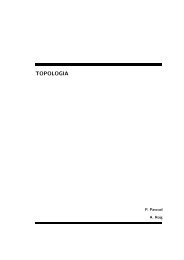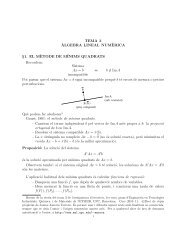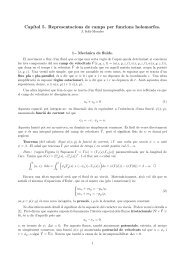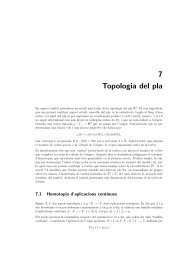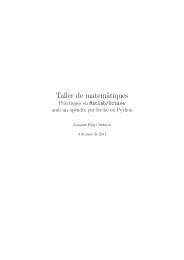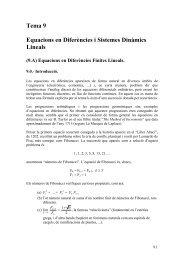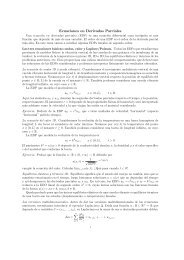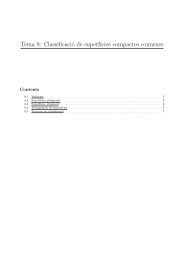Biomechanical Validation of Upper-body and Lower-body Joint - UPC
Biomechanical Validation of Upper-body and Lower-body Joint - UPC
Biomechanical Validation of Upper-body and Lower-body Joint - UPC
You also want an ePaper? Increase the reach of your titles
YUMPU automatically turns print PDFs into web optimized ePapers that Google loves.
<strong>Biomechanical</strong> <strong>Validation</strong> <strong>of</strong> <strong>Upper</strong>-<strong>body</strong><br />
<strong>and</strong> <strong>Lower</strong>-<strong>body</strong> <strong>Joint</strong> Movements<br />
<strong>of</strong> Kinect Motion Capture Data<br />
Adso Fernández-Baena<br />
La Salle - Universitat Ramon Llull<br />
adso@salle.url.edu<br />
Antonio Susín<br />
Universitat Politecnica de Catalunya<br />
toni.susin@upc.edu<br />
Abstract<br />
New <strong>and</strong> powerful hardware like Kinect introduces<br />
the possibility <strong>of</strong> changing biomechanics<br />
paradigm, usually based on expensive <strong>and</strong><br />
complex equipment. Kinect is a markerless<br />
<strong>and</strong> cheap technology recently introduced from<br />
videogame industry. In this work we conduct<br />
a comparison study <strong>of</strong> the precision in the<br />
computation <strong>of</strong> joint angles between Kinect<br />
<strong>and</strong> an optical motion capture pr<strong>of</strong>essional<br />
system. We obtain a range <strong>of</strong> disparity that<br />
guaranties enough precision for most <strong>of</strong> the<br />
clinical rehabilitation treatments prescribed<br />
nowadays for patients. This way, an easy <strong>and</strong><br />
cheap validation <strong>of</strong> these treatments can be<br />
obtained automatically, ensuring a better quality<br />
control process for the patient’s rehabilitation.<br />
Keywords: motion capture, markerless motion<br />
capture, depth camera<br />
1 Introduction<br />
Motion capture techniques are used over a very<br />
broad field <strong>of</strong> applications, ranging from digital<br />
animation for entertainment to biomechanics<br />
analysis for clinical <strong>and</strong> sport applications.<br />
Although there are other technologies, like<br />
inertial [1][2] or electromagnetics sensors [3],<br />
Xavier Lligadas<br />
LABSID SL.<br />
lligadas@labsid.com<br />
at present, using optical systems with reflective<br />
markers is the most common technique [4] [5]<br />
[6]. Despite their popularity, marker based<br />
methods have several limitations: usually a<br />
controlled environment is required to acquire<br />
high-quality data <strong>and</strong> the time required for<br />
marker placement can be excessive [7][8][9].<br />
Several recent review articles have summarized<br />
the common shortfalls <strong>of</strong> skin based marker<br />
techniques [10] [11] [12]. Markerless motion<br />
capture <strong>of</strong>fers an attractive solution to the problems<br />
associated with marker based methods,<br />
but the general problem <strong>of</strong> estimating the free<br />
motion <strong>of</strong> the human <strong>body</strong> is underconstrained<br />
without the spatial <strong>and</strong> temporal correspondence<br />
that tracked markers guarantee.<br />
From the powerful game industry new<br />
devices like Kinect [13] have been appear,<br />
allowing to interact with game consoles in<br />
real time. Moreover, this new hardware is<br />
considerably cheaper than the usual complex<br />
multicamera systems. Kinect can be thought<br />
as a 3D markerless motion capture system<br />
because it gives you a simplified skeleton in real<br />
time. No especial dress or other equipament<br />
is required. The skeleton is made <strong>of</strong> 15 joints<br />
(see Figure 5) <strong>and</strong> due to its simplification it<br />
can not be used (by now) for very accurate
studies. Because <strong>of</strong> that, we aim to use it when<br />
such accuracy it is not needed, like clinical<br />
rehabilitation where the correctness <strong>of</strong> a motion<br />
can be validate without been extremely precise.<br />
For these kind <strong>of</strong> applications, in this paper we<br />
consider the validation <strong>of</strong> the Kinect data in<br />
terms <strong>of</strong> joint angles when motion <strong>of</strong> the main<br />
limbs is involved. We compare these data with a<br />
pr<strong>of</strong>essional motion capture equipment <strong>and</strong> we<br />
compute the error along the complete capture.<br />
For the biomechanics community <strong>and</strong> clinical<br />
therapy in general, it is needed a validation<br />
<strong>of</strong> the precision <strong>of</strong> this new devices <strong>and</strong> to<br />
underst<strong>and</strong> the possible appropriate applications<br />
for these cheap <strong>and</strong> portable technology. As it<br />
is shown in section 4, the obtained accuracy<br />
for the measurements <strong>of</strong> the angle joints are<br />
enough for most <strong>of</strong> the prescribed exercises in<br />
rehabilitation treatments. As a conclusion, we<br />
think that a new series <strong>of</strong> useful applications<br />
using these new technology can be developed<br />
according to our results.<br />
The rest <strong>of</strong> the paper is organized as follows:<br />
section 2 describes the equipment used in our<br />
study, section 3 describes the motion capture<br />
performance <strong>and</strong> in section 4 we present the results.<br />
2 Equipment description<br />
Motion capture is the process <strong>of</strong> registering<br />
movements performed by a person, who is<br />
called actor, by some mechanisms or devices.<br />
Motion capture systems can be categorized in<br />
two main groups: markers motion capture or<br />
markerless motion capture. Capturing motion<br />
with markers implies using some kind <strong>of</strong><br />
sensors or devices that the actor must wear to<br />
help cameras recognizing motion or to send<br />
data to a manager system for further treatment.<br />
This fact can produce some distortion in motion<br />
because actor could be uncomfortable or simply<br />
constrained for this devices. In the other h<strong>and</strong>,<br />
markerless motion capture avoid these problems<br />
because is based on computer vision algorithms<br />
that deal with images from capturing cameras.<br />
Although, this type <strong>of</strong> motion capture usually<br />
has less precision than markers one.<br />
Markerless motion capture is based on how<br />
computer vision algorithms interprets captured<br />
images from cameras. There is a lot <strong>of</strong> literature<br />
about this type <strong>of</strong> algorithms. Moeslund has<br />
been done an extens review in [14] [15]. In<br />
addition to the algorithms is very important the<br />
type <strong>of</strong> the cameras <strong>and</strong> the set up. Markerless<br />
motion capture could be done using a camera,<br />
using stereographic cameras, 3D cameras or<br />
multiple cameras. Using only a unique camera<br />
avoid synchronization problems faced by<br />
systems with multiple cameras, although these<br />
increase precision in tracking results.<br />
In this project, we have been compared<br />
motion capture data from Kinect against optical<br />
motion capture data. In the following points<br />
there is a description <strong>of</strong> both used systems.<br />
2.1 Optical Motion Capture<br />
As we have mentioned before, optical motion<br />
capture systems are the most popular <strong>and</strong> the<br />
most used in videogames <strong>and</strong> medical fields.<br />
In [16][17] there are an extensive explanation<br />
<strong>of</strong> optical motion capture process detailing<br />
all steps included. A typical optical system<br />
consists in a set <strong>of</strong> cameras from 4 to 32 <strong>and</strong><br />
a computer that manage them. Usually, actor<br />
takes some markers that are reflective (passive)<br />
or emitters (active). Passive markers are made<br />
with reflective materials <strong>and</strong> its shape is spherical,<br />
semispherical or circular. Markers are<br />
place directly over actor skin or over an elastic<br />
suit. In passive systems, cameras are equipped<br />
with infrared LEDs diodes <strong>and</strong> light emitted is<br />
reflected by markers. In the other h<strong>and</strong>, markers<br />
in active systems are LEDs.<br />
Cameras in these systems can capture between<br />
30 <strong>and</strong> 2000 frames per second. At least,<br />
two cameras have to visualize one marker in<br />
order to determine its 3D position, although it<br />
is better than three or more cameras for better<br />
precision. In some occasions, who is been<br />
captured, or another actor, or some object can<br />
occlude some <strong>of</strong> the markers. When these<br />
occlusions exist, any camera can see these<br />
markers <strong>and</strong> this cause data losing. After
capture sessions, motion data is cleaned trying<br />
to remove some noisy data <strong>and</strong> recovering<br />
missing markers. Because <strong>of</strong> this, optical<br />
motion capture data is very accurate <strong>and</strong> we<br />
will use it as reference for testing Kinect motion<br />
capture accuracy.<br />
In this work we have been used MediaLab<br />
[18] facilities. MediaLab is a passive optical<br />
motion capture laboratory belonging to La Salle<br />
- Universitat Ramon Llull (Barcelona). This<br />
laboratory has 24 Vicon [19] cameras that allow<br />
a 45 m 2 <strong>of</strong> capture volum.<br />
2.2 Kinect Motion Capture<br />
Evolution <strong>of</strong> entertainment industry <strong>and</strong> continuous<br />
development <strong>of</strong> digital devices, it has been<br />
manufactured cameras capable <strong>of</strong> generate 3D<br />
models. This type <strong>of</strong> cameras are called depth<br />
cameras. Planar images captured by traditional<br />
cameras lose 3D information about the scenes.<br />
Depth information is very useful <strong>and</strong> important<br />
in order to visualize <strong>and</strong> perceive real world<br />
environment, so this feature permits increment<br />
the interactivity <strong>and</strong> user experience in virtual<br />
worlds. There are some type <strong>of</strong> 3D cameras on<br />
market. Nowadays, Kinect is the most popular.<br />
Kinect device appears in November <strong>of</strong> 2010<br />
as a entertainment device <strong>of</strong> Micros<strong>of</strong>t Xbox<br />
[20] console. It is based on s<strong>of</strong>tware developed<br />
by Rare [21], Micros<strong>of</strong>t Game Studios affiliated<br />
company, <strong>and</strong> the technology <strong>of</strong> PrimeSense<br />
[22] cameras. These cameras interpret 3D<br />
scene information based on projected infrared<br />
light system called Light Coding. Kinect RGB<br />
camera uses a 8 bits VGA resolution (640x480<br />
pixels) while its monocrom depth sensor has<br />
a VGA resolution <strong>of</strong> 11 bits that allows 2048<br />
sensibility levels. Both video outputs work<br />
at 30 frames per second. Kinect device has<br />
an approximate depth limitation from 0.7 to 6<br />
meters. Horizontal angular field <strong>of</strong> view is 57 o<br />
<strong>and</strong> 43 o vertically. Horizontal field <strong>of</strong> view has<br />
a minimum distance around 0.8 meters <strong>and</strong> 0.63<br />
meters in vertical, so Kinect has an approximate<br />
resolution <strong>of</strong> 1.3 millimeters per pixel.<br />
Thus, Kinect is a device capable to extract<br />
color <strong>and</strong> depth information from scenes. In<br />
order to use Kinect as a motion capture system<br />
we need an specific s<strong>of</strong>tware connected to<br />
it. OpenNI [23] framework <strong>and</strong> Primesense’s<br />
NITE (Natural Interaction Technology for<br />
End-user) [24] middleware have been used.<br />
OpenNI is a multiplatform framework that defines<br />
API’s for natural interaction applications<br />
development. This framework <strong>of</strong>fers a set <strong>of</strong><br />
libraries to be implemented by devices <strong>and</strong><br />
middleware components. Primesense’s NITE<br />
middleware can work together with OpenNI <strong>and</strong><br />
includes a set <strong>of</strong> computer vision algorithms<br />
capable <strong>of</strong> converting depth images into useful<br />
information.<br />
Figure 1: User segmentation <strong>and</strong> user tracking<br />
workflow.<br />
NITE’s algorithms [25] we have used are<br />
user segmentation <strong>and</strong> user tracking. In Figure<br />
1 there is on overview <strong>of</strong> how these algorithms<br />
work together. User tracking algorithm needs<br />
user segmentation to be successful. Once the<br />
system is able to segment an user, it starts the<br />
user tracking algorithm. First, user tracking<br />
needs to calibrate the segmented user. It is<br />
m<strong>and</strong>atory that user performs a calibration pose<br />
<strong>and</strong> waits up to calibration is complete. From<br />
this moment, the system starts to report global<br />
positions <strong>of</strong> estimated joints <strong>and</strong> its global<br />
orientation. Skeleton pr<strong>of</strong>ile is described in
Figure 5.<br />
3 Capture Description<br />
We want to record motions with optical motion<br />
capture <strong>and</strong> Kinect simultaneosly, <strong>and</strong> this leads<br />
to mount Kinect device inside the motion capture<br />
laboratory. As we can see in Figure 2,<br />
Kinect was mounted above a tripod placed in<br />
front <strong>of</strong> the actor. In case <strong>of</strong> the optical motion<br />
capture, it was normally set.<br />
Figure 2: Actor in motion capture laboratory<br />
with a Kinect mounted in front <strong>of</strong> him.<br />
To test Kinect accuracy, we have studied<br />
movements from upper <strong>body</strong> <strong>and</strong> lower <strong>body</strong><br />
following all <strong>body</strong> planes (Figure 3). So, we select<br />
three joints: shoulder, hip <strong>and</strong> knee. For<br />
the shoulder we have recorded movements in all<br />
planes <strong>of</strong> the <strong>body</strong>, in case <strong>of</strong> hip, sagital <strong>and</strong><br />
coronal rotations. To validate the movement <strong>of</strong><br />
the knee, flexion <strong>and</strong> extension movements were<br />
recorded.<br />
Recording motion with two independent<br />
systems requires some kind <strong>of</strong> synchronization<br />
when you start recording a movement. Additionally,<br />
each system needs some specific<br />
steps to be initialized. In case <strong>of</strong> Kinect, it<br />
is indispensable to calibrate user in order to<br />
get joint positions. So, at the beginning <strong>of</strong> the<br />
capture session, user was asked to be calibrated<br />
by Kinect system. From this point, Kinect was<br />
reporting tracking information. In the other<br />
Figure 3: Body planes.<br />
h<strong>and</strong>, optical motion capture workflow forces<br />
actor to start every clip in t-pose for later easy<br />
data cleaning. So, we manually activate both<br />
systems when actor was in t-pose. Each system<br />
capture motion <strong>and</strong> save it in a specific way<br />
that will be explained in depth in the following<br />
sections. Temporal synchronization between<br />
pairs <strong>of</strong> motions is obviously not very accurate.<br />
In Section 4 we will explain how we have fixed<br />
synchronization problem. Finally, we have<br />
obtained the amount <strong>of</strong> data described in Table<br />
1. We have recorded capture sessions in video<br />
too.<br />
<strong>Joint</strong> Plane <strong>of</strong> movement Frames<br />
Knee Relative to parent 5998<br />
Hip Sagittal 3152<br />
Hip Coronal 1893<br />
Shoulder Sagittal 4261<br />
Shoulder Coronal 3114<br />
Shoulder Traversal 2018<br />
Table 1: Recorded movements.<br />
3.1 Optical Motion Data<br />
As we have explained before, to capture motion<br />
using an optical system actor have to wear<br />
attached optical markers whose positions are<br />
reported. On the contrary, Kinect motion<br />
capture system reports joint positions. So,<br />
in order to compare them it is m<strong>and</strong>atory to<br />
adapt one representation to the other. We have
created a markers configuration to calculate<br />
joint positions from markers. We have placed<br />
two markers in each joint that Kinect system is<br />
able to track. Markers have been placed by a<br />
therapist, trying to minimize a bad placement<br />
that will affect joint positions computing. In<br />
Figure 4 can be seen in detail markers configuration.<br />
Figure 4: On top, placement <strong>of</strong> markers on the<br />
actor’s <strong>body</strong> on both sides; <strong>and</strong> below,<br />
detail <strong>of</strong> the placement <strong>of</strong> markers for<br />
calculating the position <strong>of</strong> the head,<br />
shoulder, elbow, knee <strong>and</strong> foot.<br />
Optical data was recorded with a framerate<br />
<strong>of</strong> 120 <strong>and</strong> markers positions were expressed<br />
in world coordinate system. After making the<br />
recordings, optical motion data was cleaned <strong>and</strong><br />
post-process to eliminate mistakes in capture<br />
<strong>and</strong> recover missing markers. So, each optical<br />
capture was perfectly prepared <strong>and</strong> validated.<br />
3.2 Kinect Motion Data<br />
Kinect motion data depends on the joints that<br />
NITE user tracking algorithm can detect. This<br />
algorithm is able to report joints positions <strong>and</strong><br />
global orientations. Although we want to validate<br />
joint rotations, we have been used joint positions.<br />
We made this decision because orientation<br />
data is computed from position data, so<br />
errors from position data are propagated. Therefore<br />
joint positions are more reliable. <strong>Joint</strong> specification<br />
is shown in Figure 5. <strong>Joint</strong> positions<br />
are referred to a world coordinate system with<br />
the origin placed in Kinect device. Tracking algorithm<br />
also report a confidence value for each<br />
joint. This value is a boolean parameter that indicates<br />
if joint position is reliable for the system.<br />
We have saved this information for each<br />
joint too. Apart from this, as we have mentioned<br />
in Kinect device description, Kinect can report<br />
camera data at 30 frames per second. So, Kinect<br />
motion data was recorded at this framerate.<br />
Figure 5: OpenNI joint specification.<br />
Estimated positions by Kinect suffer a lot <strong>of</strong><br />
noise. Tracking algorithm recompute at each<br />
frame all joint positions regardless <strong>of</strong> temporal<br />
continuity, this fact produces noise mentioned.<br />
Due to this problem we have been used a smooth<br />
lowpass filter to eliminate local fluctuations.<br />
4 Motion Data Processing<br />
In this section we describe how we have processed<br />
motion data from both capture systems to<br />
compare results. Data correspondence from motion<br />
data consists in the conversion <strong>of</strong> markers
position data to joint position data, temporal <strong>and</strong><br />
spatial alignment <strong>of</strong> each pair <strong>of</strong> motions. After<br />
that, we have computed joint rotations which we<br />
want to evaluate.<br />
4.1 Data correspondence<br />
We converted the optical motion capture data<br />
to the representation <strong>of</strong> Kinect motion data in<br />
order to enable comparison between them. First<br />
<strong>of</strong> all we have aligned the same movement from<br />
both systems in terms <strong>of</strong> coordinate system.<br />
Optical motion data is reported in its world<br />
coordinates ((a) in Figure 6 ), <strong>and</strong> the same for<br />
Kinect data ((d) in Figure 6 ). Both coordinate<br />
systems have the same orientation but they have<br />
exchanged axes. We have corrected it as shown<br />
(b) in Figure 6.<br />
Figure 6: Steps from data correspondence. (a)<br />
Markers from optical motion capture.<br />
(b) Rotated markers from optical motion<br />
capture. (c) <strong>Joint</strong> positions from<br />
optical markers. (d) <strong>Joint</strong> positions<br />
from Kinect motion capture.<br />
<strong>Joint</strong> correspondence consists in compute<br />
joint positions from optical motion data <strong>of</strong> the<br />
markers. As we have explained before, we have<br />
used an specific markers placement to solve<br />
this. Each joint position that Kinect is able to<br />
track is estimated from two optical markers. To<br />
achieve this is very simple since you just have<br />
to calculate the midpoint between marker pairs.<br />
In (c) <strong>of</strong> Figure 6 it can be observed the result<br />
<strong>of</strong> this step. Now the appearence <strong>of</strong> optical data<br />
is like Kinect data.<br />
Capturing with two different systems produce<br />
some temporal differences according to<br />
technical equipment features. First, there is<br />
a difference between framerates used in both<br />
motion capture systems. In case <strong>of</strong> Kinect, a<br />
framerate <strong>of</strong> 30 frames per second is used. In<br />
the other h<strong>and</strong>, the optical motion capture that<br />
we used record at a speed <strong>of</strong> 120 frames per<br />
second. So, we have time scaled data acquired<br />
by optical system.<br />
Both motions have the same velocity but<br />
they are still unsynchronized. At this moment<br />
we have pairs <strong>of</strong> motions that their beginnings<br />
<strong>and</strong> endings are close between them, but not<br />
exactly at same time because synchronization<br />
was manually done. In order to fix it we<br />
have searched which is the point when the<br />
actor leaves t-pose <strong>and</strong> starts performing the<br />
appropiate movement. We have observed in<br />
video recordings that actor tends to lower the<br />
arms just after staying in t-pose. So, we have<br />
detected this decreasement in vertical axis <strong>of</strong><br />
h<strong>and</strong>s position using a velocity threshold value.<br />
Definitely we have motion pairs expressed<br />
in the same way <strong>and</strong> synchronized. To evaluate<br />
if data processing is successful, we have<br />
implemented a visualization tool for qualitative<br />
revision. In Figure 7 there is a captured screen<br />
<strong>of</strong> that application.<br />
4.2 Rotational Data<br />
We have 3D positions <strong>of</strong> specified joints from<br />
both motion capture systems. Our goal is to<br />
compare joint rotations instead <strong>of</strong> positions. So,<br />
we have extracted the desired rotations from<br />
position data . To compute these rotations we<br />
can distinguish the calculation <strong>of</strong> knee rotation<br />
<strong>and</strong> the rest. Knee rotation is the angle between<br />
two vectors, one from knee to foot <strong>and</strong> the<br />
other from knee to hip. This is because knee
Figure 7: Visualization tool. On the left side, there are controls to manage the visualization <strong>of</strong> pairs<br />
<strong>of</strong> motions which are right next. Estimated joint positions from Kinect are coloured in blue<br />
<strong>and</strong> markers positions are in red. On the right side, we can see a graph <strong>of</strong> visualized data.<br />
The buttons below allow to select the movements data from different joints. Also we can<br />
select if we want to observe data from Kinect, from Mocap or the difference between them<br />
using the middle buttons.<br />
has only one degree <strong>of</strong> freedom. In case <strong>of</strong><br />
other rotations, we have computed rotation<br />
values respect to <strong>body</strong> planes (Figure 3). This<br />
calculation consists on creating a vector from<br />
joint to its child joint <strong>and</strong> compute the angle<br />
between this vector <strong>and</strong> a perpendicular vector<br />
to the desired <strong>body</strong> plane. In Figure 8 we can<br />
observe described vectors for extracting desired<br />
rotations.<br />
Figure 8: Extracted rotations. On the left, vectors<br />
for computing knee angle; on the<br />
middle, vector for computing hip direction;<br />
on the right, vector for computing<br />
shoulder direction; <strong>and</strong> below,<br />
perpendicular vectors to <strong>body</strong> planes.<br />
5 Results<br />
To evaluate the performance <strong>of</strong> Kinect as a<br />
motion capture system we have compared the<br />
reported joint rotational values from this system<br />
against data from optical motion capture. Figure<br />
9 shows 3 joint angle trajectories from different<br />
motion clips. As we can see, signals from kinect<br />
<strong>and</strong> optical system have an evidence correlation<br />
because they are synchronized <strong>and</strong> follow the<br />
same pattern.<br />
The aim <strong>of</strong> this comparison is to know how<br />
accurate is Kinect in terms <strong>of</strong> degrees. So, we<br />
have computed the mean error (ME) <strong>and</strong> the<br />
mean error relative to range <strong>of</strong> motion (MER)<br />
for each motion clip. MER is calculated by<br />
MERM = 1<br />
m<br />
m<br />
(Ki − Oi)/ROM (1)<br />
i=1<br />
where M is a motion clip, m is the frames<br />
length <strong>of</strong> motion clip M, Ki <strong>and</strong> Oi are joint<br />
angle from kinect motion capture <strong>and</strong> optical<br />
motion capture in frame i respectively, <strong>and</strong><br />
ROM is the range <strong>of</strong> motion.<br />
Rotation comparisons have been done for<br />
knee, hip <strong>and</strong> shoulder joints. All treatened<br />
joint values <strong>of</strong> Kinect motion data have a true
Figure 9: <strong>Joint</strong> angle trajectories. In red color, Kinect motion data; in blue color, optical motion data.<br />
From top to down, knee, hip <strong>and</strong> shoulder from different motion clips.<br />
confidence parameter belonging to tracking algorithm.<br />
In the case <strong>of</strong> knee we can summarize<br />
results in Table 2. All degree error are lower<br />
than 10 o ranging from 6.78 o to 8.98 o . Dynamic<br />
ranges <strong>of</strong> motion are between 89 o <strong>and</strong> 115 o .<br />
ME is increasing when ROM is higher. It<br />
occurs because in extrem rotations leg is perpendicular<br />
to kinect camera doing more difficult<br />
to track hip <strong>and</strong> knee. Even in this situation<br />
would be difficult for a person to determine the<br />
pose. These results are good enough for some<br />
physical therapies based on repetitions, because<br />
nowadays therapists visually controls the range<br />
<strong>of</strong> motion <strong>and</strong> it is assumed that it has at least<br />
10 o approximate error.<br />
M Frames ROM MER ME<br />
1 2112 89.29 o 0.07 6.78 o<br />
2 2033 93.41 o 0.08 7.94 o<br />
3 1853 115.07 o 0.07 8.98 o<br />
Table 2: Knee results.<br />
In case <strong>of</strong> hip, we have compared sagittal<br />
<strong>and</strong> coronal rotation. In Table 3 there are hip<br />
results where the two first motions contain<br />
the sagittal movement <strong>and</strong> the following the<br />
coronal movement. Sagittal ME is around 5 o<br />
<strong>and</strong> coronal is ranged from 6 o to 10 o . Sagittal<br />
ranges <strong>of</strong> motion are around 90 o <strong>and</strong> coronal<br />
are 77 o <strong>and</strong> 38 o . Errors in sagittal movements<br />
are lower than the other cases, however errors<br />
in coronal plane are lower than 10 o .<br />
M Frames ROM MER ME<br />
4 1880 89.42 o 0.06 5.53 o<br />
5 1370 90.12 o 0.06 5.88 o<br />
6 1272 77.07 o 0.13 9.92 o<br />
7 1893 38.63 o 0.17 6.49 o<br />
Table 3: Hip results. Motion 4 <strong>and</strong> 5 contain<br />
saggital movements; motion 6 <strong>and</strong> 7 are<br />
coronal movements.<br />
Shoulder rotations are the most complete<br />
<strong>of</strong> our study because this joint has 3 degrees<br />
<strong>of</strong> freedom. In this case, we have obtained<br />
results that are varying between 7 o to 13 o in all
plane rotations. The four first motions contain<br />
movements in sagittal plane; motion 12 <strong>and</strong><br />
13 are coronal movements <strong>and</strong> the two last are<br />
transverse movements. For this joint there is no<br />
direct relation between ROM <strong>and</strong> errors cause<br />
we have sparse results.<br />
M Frames ROM MER ME<br />
8 1655 125.04 o 0.06 8.02 o<br />
9 793 139.08 o 0.05 7.19 o<br />
10 558 128.31 o 0.08 9.75 o<br />
11 1255 120.14 o 0.07 8.41 o<br />
12 2302 71.39 o 0.16 11.33 o<br />
13 812 73.14 o 0.11 8.34 o<br />
14 1359 89.10 o 0.13 11.80 o<br />
15 659 82.53 o 0.15 13.19 o<br />
Table 4: Shoulder results. From motion 8 to 11<br />
are saggital movements; motion 12 <strong>and</strong><br />
13 are coronal movements; motion 14<br />
<strong>and</strong> 15 are transverse movements.<br />
6 Conclusions <strong>and</strong> Future Work<br />
We have presented a precision comparative<br />
study between two very different equipments.<br />
One very accurate <strong>and</strong> expensive motion capture<br />
system <strong>and</strong> the new easy <strong>and</strong> cheap device<br />
Kinect. We think our results would be very<br />
interesting for the biomechanics community<br />
<strong>and</strong> computer animation in general.<br />
As we have shown, the precision <strong>of</strong> the<br />
Kinect is, <strong>of</strong> course, less than the optical<br />
motion capture system, but has several other<br />
advantages: prize, portability <strong>and</strong> markless.<br />
The precision ranks obtained for the main joints<br />
<strong>of</strong> the <strong>body</strong> allows as to confirm that Kinect can<br />
be a very useful technology in present rehabilitation<br />
treatments. In fact, we have developed<br />
a first application for knee rehabilitation that<br />
automatically counts repetition movements <strong>and</strong><br />
validates the quality <strong>of</strong> such a motion.<br />
The precision <strong>of</strong> the Kinect captures can<br />
be increased by imposing some fixed length<br />
restriction for the bones (now it can be different<br />
in each frame). One can also help the system<br />
using some incremental tracking strategy, now<br />
it is frame independent. For biomechanics<br />
applications, the human joint motion rank can<br />
also be included as a restriction <strong>of</strong> the system.<br />
These can be several future works to improve<br />
the present results obtained using Kinect.<br />
Another possibility is to work directly with the<br />
depth map information <strong>and</strong> try to get a better<br />
approximation <strong>of</strong> joint <strong>and</strong> bones positions<br />
using a retargeting method.<br />
Acknowledgements<br />
We are very grateful to the direction <strong>of</strong> Creation,<br />
Design <strong>and</strong> Serious Game Master Program <strong>and</strong><br />
La Salle - Universitat Ramon Llull for the help<br />
in using their facilities. The authors would like<br />
to thank therapist Bernat Pascual for performing<br />
the movements in motion capture sessions<br />
<strong>and</strong> for placing optical markers in their correct<br />
places. Also thank Eduard Ruesga <strong>and</strong> Meritxell<br />
Aragonés for his work in recording <strong>and</strong><br />
cleaning motion capture clips. We acknowledge<br />
David Miralles for his helpful discussions <strong>and</strong><br />
reviewing advices. This research was partially<br />
supported by LABSID SL <strong>and</strong> TIN2010-20590-<br />
C02-01.<br />
References<br />
[1] Xsens. Xsens: 3D Motion Tracking.<br />
http://www.xsens.com/, Dec 2011.<br />
[2] Animazoo. Animazoo Motion<br />
Capture Systems <strong>and</strong> Technology.<br />
http://www.animazoo.com/, Dec 2011.<br />
[3] Ascension Technology Corporation.<br />
Ascension Technology Corporation.<br />
http://www.ascension-tech.com/, Dec<br />
2011.<br />
[4] A Cappozzo, F Catani, U Della Croce, <strong>and</strong><br />
A Leardini. Position <strong>and</strong> orientation in<br />
space <strong>of</strong> bones during movement: anatomical<br />
frame definition <strong>and</strong> determination.<br />
Clinical Biomechanics, 10(4):171 – 178,<br />
1995.<br />
[5] Roy B Davis, Sylvia Ounpuu, Dennis Tyburski,<br />
<strong>and</strong> James R Gage. A gait analysis<br />
data collection <strong>and</strong> reduction technique.
Human Movement Science, 10(5):575–<br />
587, 1991.<br />
[6] C Frigo, M Rabuffetti, D C Kerrigan,<br />
L C Deming, <strong>and</strong> A Pedotti. Functionally<br />
oriented <strong>and</strong> clinically feasible quantitative<br />
gait analysis method. Medical<br />
<strong>and</strong> Biological Engineering <strong>and</strong> Computing,<br />
36(2):179–185, 1998.<br />
[7] A Cappozzo, F Catani, A Leardini,<br />
MG Benedetti, <strong>and</strong> U Della Croce. Position<br />
<strong>and</strong> orientation in space <strong>of</strong> bones<br />
during movement: experimental artefacts.<br />
Clinical Biomechanics, 11(2):90 – 100,<br />
1996.<br />
[8] J. Fuller, L.-J. Liu, M.C. Murphy, <strong>and</strong> R.W.<br />
Mann. A comparison <strong>of</strong> lower-extremity<br />
skeletal kinematics measured using skin<strong>and</strong><br />
pin-mounted markers. Human Movement<br />
Science, 16(2-3):219 – 242, 1997. 3-<br />
D Analysis <strong>of</strong> Human Movement - II.<br />
[9] J. A. De Guise S. Larouche Sati, M. <strong>and</strong><br />
G. Drouin. Quantitative assessment <strong>of</strong> skin<br />
marker movement at the knee. The Knee,<br />
3:121–138, 1996.<br />
[10] S Corazza, L Mndermann, A M Chaudhari,<br />
T Demattio, C Cobelli, <strong>and</strong> T P Andriacchi.<br />
A markerless motion capture system<br />
to study musculoskeletal biomechanics:<br />
visual hull <strong>and</strong> simulated annealing<br />
approach. Annals <strong>of</strong> Biomedical Engineering,<br />
34(6):1019–1029, 2006.<br />
[11] Ugo Della Croce, Alberto Leardini,<br />
Lorenzo Chiari, <strong>and</strong> Aurelio Cappozzo.<br />
Human movement analysis using<br />
stereophotogrammetry: Part 4: assessment<br />
<strong>of</strong> anatomical l<strong>and</strong>mark misplacement <strong>and</strong><br />
its effects on joint kinematics. Gait &<br />
Posture, 21(2):226 – 237, 2005.<br />
[12] Lorenzo Chiari, Ugo Della Croce, Alberto<br />
Leardini, <strong>and</strong> Aurelio Cappozzo. Human<br />
movement analysis using stereophotogrammetry:<br />
Part 2: Instrumental errors.<br />
Gait & Posture, 21(2):197 – 211, 2005.<br />
[13] Micros<strong>of</strong>t Xbox. Kinect.<br />
http://www.xbox.com/kinect, Dec 2011.<br />
[14] Thomas B. Moeslund <strong>and</strong> Erik Granum.<br />
A survey <strong>of</strong> computer vision-based human<br />
motion capture. Comput. Vis. Image Underst.,<br />
81:231–268, March 2001.<br />
[15] Thomas B. Moeslund, Adrian Hilton, <strong>and</strong><br />
Volker Krüger. A survey <strong>of</strong> advances in<br />
vision-based human motion capture <strong>and</strong><br />
analysis. Comput. Vis. Image Underst.,<br />
104:90–126, November 2006.<br />
[16] B Bodenheimer, C Rose, S Rosenthal, <strong>and</strong><br />
J Pella. The process <strong>of</strong> motion capture:<br />
Dealing with the data. Computer Animation<br />
<strong>and</strong> Simulation, pages 3–18, 1997.<br />
[17] Gutemberg B. Guerra-filho. Optical motion<br />
capture: Theory <strong>and</strong> implementation.<br />
Journal <strong>of</strong> Theoretical <strong>and</strong> Applied Informatics<br />
(RITA, 12:61–89, 2005.<br />
[18] La Salle Universitat Ramon Llull. MediaLab.<br />
Motion Capture, RV + RA,<br />
Animation, Videogames <strong>and</strong> CAD.<br />
http://www.salleurl.edu/medialab, Dec<br />
2011.<br />
[19] Vicon. Motion Capture Systems from Vicon.<br />
http://www.vicon.com/, Dec 2011.<br />
[20] Micros<strong>of</strong>t. Micros<strong>of</strong>t Xbox.<br />
http://www.xbox.com/, Dec 2011.<br />
[21] Rare Ltd. Rare. http://www.rare.co.uk/,<br />
Dec 2011.<br />
[22] PrimeSense Ltd. Primesense Natural Interaction.<br />
http://www.primesense.com/, Dec<br />
2011.<br />
[23] OpenNI. OpenNI Home.<br />
http://www.openni.org/, Dec 2011.<br />
[24] PrimeSense Ltd. PrimeSense Natural<br />
Interaction Technology for Enduser.<br />
http://www.primesense.com/nite,<br />
Dec 2011.<br />
[25] PrimeSense. Prime Sensor NITE 1.3 Algorithms<br />
notes. PrimeSense NITE Documentation,<br />
2010.


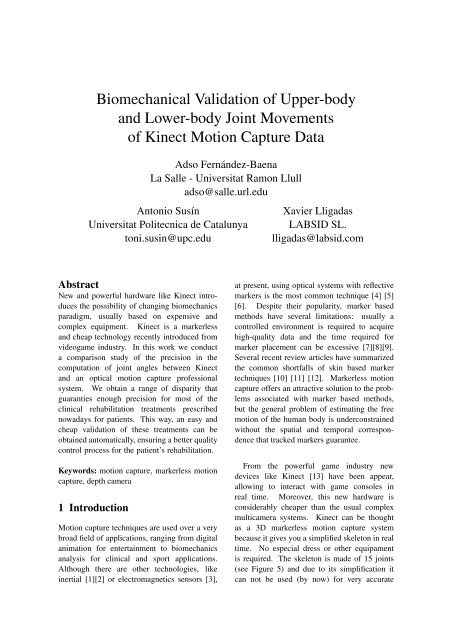
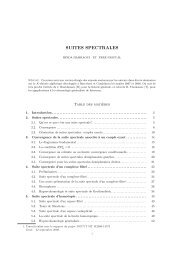
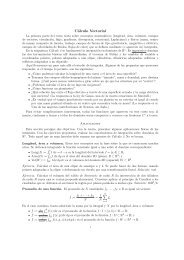
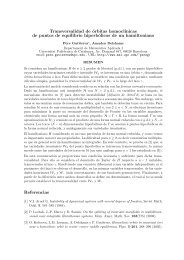
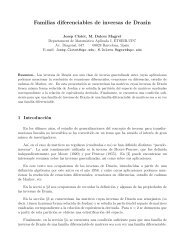
![INTEGRALES ELÍPTICAS COMPLETAS Dado un parámetro m ∈ [0,1]](https://img.yumpu.com/14067465/1/184x260/integrales-elipticas-completas-dado-un-parametro-m-01.jpg?quality=85)
